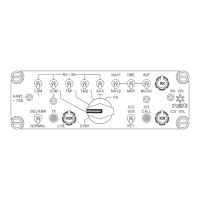AA9x Series Single Channel Audio Controller
SM56 Installation and Operation Manual
May 22, 2012 Rev: 2.00 Page 2-4
ENG-FORM: 805-0100.DOTX
CONFIDENTIAL AND PROPRIETARY TO ANODYNE ELECTRONICS MANUFACTURING CORP.
2.4.5 Post Installation Checks
2.4.5.1 Voltage/Resistance Checks
Do not attach the AA9x Series until the following conditions are met.
Check the following:
a) Check P101, pins <16> and <17> for +28 Vdc relative to ground.
b) Check P101 pin <34> for continuity to ground (less than 0.5:).
c) Check P102 pin <19> for lights buss voltage.
d) Check all Mic, phone, music and key lines for shorts to ground or adjacent pins.
2.4.5.2 Power On Checks
Power up the aircraft’s systems and confirm normal operation of all functions of the AA9x Series. Refer to
Section 3 (Operation) for specific operational details.
a) Begin with only the Pilot's headset installed, no hand mic. Confirm correct radio operation,
both receive and transmit. Check yoke (or cyclic) switch action. Check radio audio inputs and
selection of same.
b) If there is a music source in the system turn it on and verify that music is muted in the CREW
mode and removed in the PLT ISO mode. Check for proper mute operation. Do not proceed
until the radios are functioning correctly. The S/T (sidetone) trimpot accessible through the left
side of the controller and the transceiver internal trimpot may have to be adjusted for correct
balance for the pilot. Adjustment of the individual radio RX levels should be set first with the AA9x
series in Pilot ISO mode; then adjust the AA9x series front panel RX master volume control level
in NORMAL mode.
c) Unusual buzzes, hums or other background audio are symptomatic of multiple grounds, or
noisy external systems such as blowers or pumps sharing wiring with the audio system.
Failure to key or correctly modulate a transmitter is often the result of forgetting to connect all
required grounds to the radio or external audio system.
d) Check the ICS Modes (ALL, CREW, PLT ISO), and the manual Fail-safe operation.
e) Plug in the Co-pilot's headset. Check for correct ICS and SPLIT transmit operation. Check
that the Co-pilot loses transmit capability during PLT ISO. Check yoke switch functions.
f) Plug in the hand mic, if installed, and test for correct operation in all modes. (Hand mic
activation does not illuminate the TX light.) Note that wiring faults for this accessory may
cause peculiar loss of ICS or TX functions because it has over-riding priority in the system.
g) Plug in any remaining headsets, and check for correct ICS operation. Note that an incorrect
cordset (drop cord) or improper jack wiring may cause a wide range of problems from loss of
audio to a tone heard in the headset. For further information, see section 2.4.4 above.
i) To verify proper operation, all functions and levels shall be checked in-flight.
j) Check preset adjustments are completed before aircraft departure.

